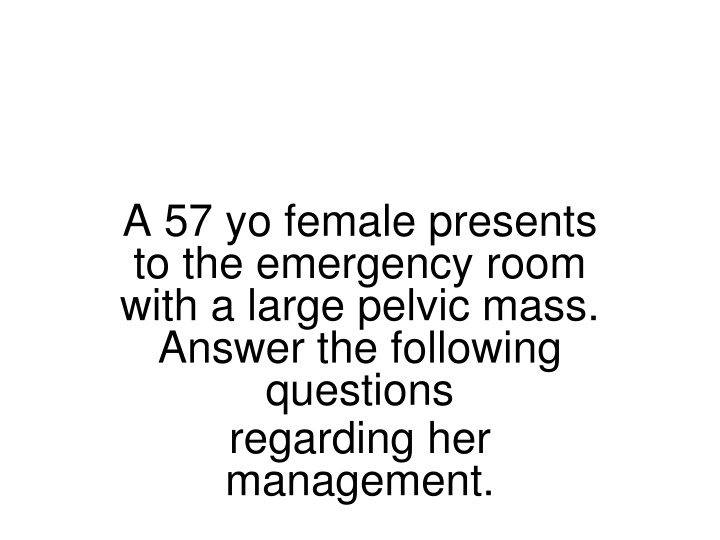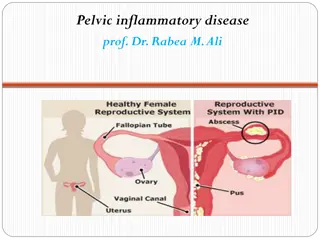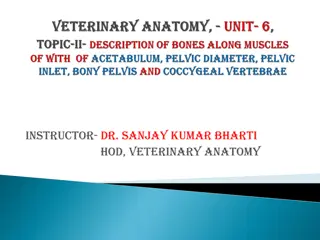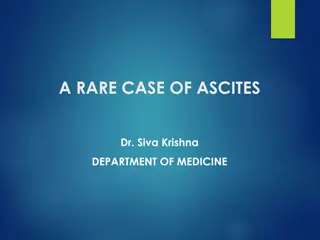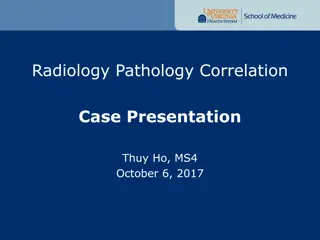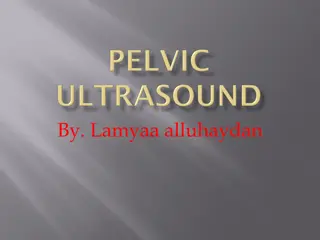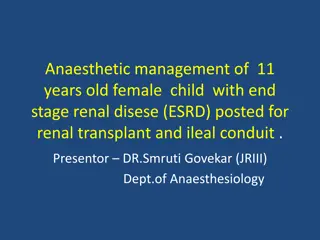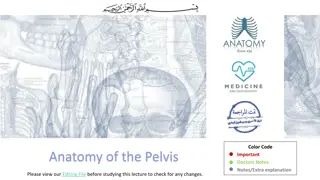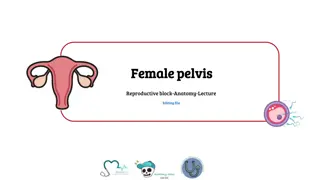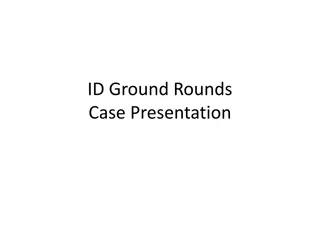Management of a 57-Year-Old Female with a Pelvic Mass: Assessments and Work-up
A 57-year-old female presents to the emergency room with a large pelvic mass. Detailed history and physical examination are crucial, focusing on risk factors, past medical history, family history, medications, habits, and social factors. Along with vital signs and lymphadenopathy evaluation, a thorough work-up is essential, including CBC, CA-125, imaging studies, and other tests to determine the differential diagnosis of the pelvic mass.
Download Presentation

Please find below an Image/Link to download the presentation.
The content on the website is provided AS IS for your information and personal use only. It may not be sold, licensed, or shared on other websites without obtaining consent from the author.If you encounter any issues during the download, it is possible that the publisher has removed the file from their server.
You are allowed to download the files provided on this website for personal or commercial use, subject to the condition that they are used lawfully. All files are the property of their respective owners.
The content on the website is provided AS IS for your information and personal use only. It may not be sold, licensed, or shared on other websites without obtaining consent from the author.
E N D
Presentation Transcript
A 57 yo female presents to the emergency room with a large pelvic mass. Answer the following questions regarding her management.
What will you look for on history and physical? HISTORY (name Risk Factors) Age Ethnicity (Ashkenazi Jewish, white) LMP, menopause Status PMH: Cancers: breast, uterine, ovarian, colon, lymphoma, DM, HTN, obesity, PSH: TL, Ovarian cysts, OR/ pathology reports FAMILY HX: breast, uterine, ovarian, Colon, lymphoma, endometriosis, fibroid MEDICATIONS: no OCP, HRT ALLERGIES: HABITS: smoking ETOH, drugs SOCIAL: occupation, marital status POBS: GPTLA, nulliparity, infertility, IVF, did not breastfeed PGYN: early menarche, late menopause, regularity of cycles, PAP hx, STI s/PID, PCOS, Hx of pelvic radiation, last mamo/ colonoscopy) (BRCA, HNPCC, age of Dx) benign gyn pathology (endometriosis, ov cysts, fibroids, adenomyosis), hot flushes, vag dryness, PM bleeding HPI: abd pain/bloating, N/V, urinary frequency / urgency/dysuria, constipation / diarrhea/dyschezia, bloody stool, early satiety / anorexia, vaginal bleeding, constitutional symptoms: fatigue, weight loss, weakness, anorexia. Symptoms progression/duration Activities of daily living/ functional status
PHYSICAL EXAM VITAL SIGNS, height weight BMI, general appearance LYMPHADENOPATHY: supraclavicular, inguinal, pelvic HEENT: thyroid, nodes CVS RESP: pleural effusion BREAST EXAM ABDOMINAL EXAM: ascites, masses, tenderness PELVIC, RECTAL AND PV/PR (cul de sac nodules/masses)
What work up you want to do? CBC, T & S Creatinine, BUN, lytes, LFT CA-125, CEA, CA 19.9 (mucinous, pancreas), 15.3 (breast) Pap test Cultures, endometrial Bx if indicated ULTRASOUND for RMI 2 score (TVUS and Abd) CXR, ECG r/o other primary as Hx indicates: Barium enema, colonoscopy, mammogram UA, cytology, C&S if positive hx BHCG Paracentesis/ omental bx can be considered: often non diagnostic. Still need surgical staging CT/ MRI/ bone scan/ PET not necessary pre-op if US and RMI score abnormal
What is your differential diagnosis of a pelvic mass? Benign (Ovarian/ Other Gyn/ GI/ GU) Endometrioma Dermoid Cystadenoma Functional ovarian cyst Ruptured / hemorrhagic ovarian cyst Fibroid, adenomyosis TOA, hyrdosalpinx, paratubal cyst Ectopic (pre menopausal) Diverticulosis Pelvic kidney MALIGNANT Primary Ovarian CA (epithelial)- borderline, cystadenocarcinoma Sex cord / stromal tumor (Granulosa cell causes PMBleed, Sertoli Leydig) Metastatic Ovarian (breast, stomach etc) Endometrial CA, Cervical mass/ cancer Uterine Sarcoma Fallopian Tube Ca Colon
What are the ultrasound criteria suggestive of an ovarian malignancy? Multiloculated, complex mass Solid echogenic components Bilateral Ascites Peritoneal nodularities > 5 cm Thick septations Papillary excrescences Central vascularity on Doppler
List the specific criteria and scoring system for the RMI II. What is the specificity of this index? RMI II = ultrasound score x [CA-125 level] x menopause score RMI II > 200 high risk of malignancy, Refer to gyn onc. List the components of the RMI 2 U/S score: Multilocular cyst, presence of solid areas, bilaterality, presence of ascites, presence of intra-abdominal mets 1 = 0 or 1 abnormality, 4 = 2 or > abnormalities Menopausal score: Premenopausal = 1 and Postmenopausal = 4 Specificity of RMI II: 90% ppv = 80%
Your patients result show the following: TVUS: bilateral ovarian masses, solid & cystic components and ascites CA-125: 100 How much is RMI score and how will you manage her?
Your patients result show the following: TVUS: bilateral ovarian masses, solid & cystic components and ascites CA-125: 100 How much is RMI score and how will you manage her? 4x4x100 = 1600 Refer to Gynecology Oncology
What will be the proposed management by the GYN-ONC team for this 57 yo? COMPREHENSIVE SURGICAL STAGING Midline laparotomy Peritoneal washings Inspection/ palpation Diaphragm, surface and parenchyma of liver, gallbladder, stomach, spleen, R+L kidney, R+L paracolic gutters, small bowel and mesentery, appendix, ascending, transverse, descending and rectosigmoid colon and mesentery, omentum, lesser sac PALN and PLN, ovaries, tubes, uterus, bladder peritoneum and cul-de-sac. TAH BSO frozen section Retroperitoneal lymphadenectomy (pelvic, paraaortic nodes) omentectomy diaphragmatic scrapings / biopsies Peritoneal biopsies of suspicious areas or adhesions If no disease, multiple biopsies of peritoneum from cul-de-sac, paracolic gutters, bladder peritoneum, intestinal mesenteries
Pathology of frozen section result shows Grade 2 papillary serous adenocarcinoma of the ovary. The patient s pelvic lymph nodes are positive. No mets are seen. What is her surgical stage? Stage IIIA1
What will be the management for this patient? Primary cytoreductive surgery Aiming for Optimal debulking (< 1cm macroscopic residual) Chemotherapy: 6-9 cycles IV carboplatinum & paclitaxel Or neoadjuvant chemo 3 cycles followed by interval debulking followed by adjuvant chemo for 3 cycles.
Name 3 serious side effects of Carboplatin, Cisplatin and Paclitaxol Carbo: myelosuppression(esp Platelets), hypersensitivity, less N&V and neuropathy Cisplatin: nephrotoxic, neuropathy, severe N&V, metallic taste, anorexia, ototoxicity, hypersensitivity, less hematologic toxicity than carbo Paclitaxol: myelosuppression, hypersensitivity, neurotoxic, alopecia
Patient presented 15 months later with an evidence of recurrent disease and she asked you about surgery what is the role for secondary cytoreductive surgery? No evidence of ascites or ascites less than 500 cc Solitary site recurrence Platinum sensitive disease Prolonged disease free interval > 12 months
What is the definition of Platinum sensitive/ resistant/ refractory? Platinum sensitive = no recurrence more than 6 months after completion of primary platinum based chemo Platinum resistance = less than 6 months before recurrence Platinum refractory = progression while on primary platinum chemo
what hereditary syndromes that you know can give rise to ovarian cancer ? BRCA1, BRCA2 HNPCC (LYNCH SYNDROME)
What % of Ovarian cancers are hereditary? Name 3 genetic mutations. 5 10% of all ovarian cancers: BRCA1, BRCA2, HNPCC lifetime risk of ovarian ca BRCA1 40%, BRCA2 25% lifetime risk of breast ca for BRCA1 or BRCA 2 56-87% Occur 10 years earlier than non-hereditary ca
What are the risks of ovarian and breast cancer in the general population and in BRCA patients? Breast Ca: 12% vs 80% Ovarian Ca: 1.3% vs 25% (BRCA2) vs 40% (BRCA1)
Describe management of pts with BRCA mutations Annual or biannual TVUS, CA 125 and pelvic exam Mammography starting at age 30 if strong family hx of breast ca alternating with MRI every 6 months. Prophylactic BSO done at age 40, post-op risk reduced to 0.8%, doesn t protect against peritoneal ca (4%), decreases risk of breast ca significantly, consider TAH BSO (reduce FT ca) OCP: Women with BRCA mutations can reduce ovarian cancer risk by 60% TL: reduces risk by 39%, decreases blood supply to ovary and decreases carcinogens passing via tube into pelvis If documented HNPCC, periodic mammography, colonoscopy and endometrial biopsy and urine cytology
How is BRCA Prognosis different from other ov ca patients Improved overall survival for BRCA cancers High grade Papillary serous histology More sensitive to radiation More sensitive to chemotherapy longer interval to recurrence
What type of ovarian Ca can you get after TAH BSO? Primary peritoneal carcinoma
What is the risk of ovarian ca in HNPCC pts? & What % of hereditary ov ca is due to HNPCC? 3-fold increase risk in ovarian ca 16% of hereditary ovarian ca
What decreases a womans risk of Ov Ca? Surgery: TL, BSO, Salpingectomy Decreased estrogenic effect: Multiparity, breastfeeding, OCP
